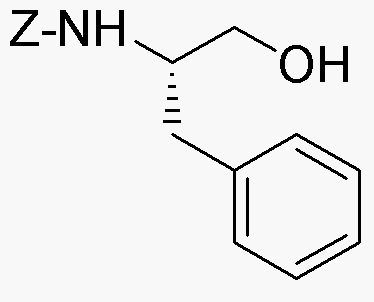Z-L-phenylalaninol is widely utilized in research focused on:
- Synthesis of Pharmaceuticals: This compound serves as a chiral building block in the synthesis of various pharmaceuticals, enhancing the efficacy and selectivity of drug formulations.
- Asymmetric Catalysis: It plays a crucial role in asymmetric synthesis, aiding chemists in producing enantiomerically pure compounds, which are vital in the development of effective medications.
- Biochemical Research: Researchers use it to study enzyme mechanisms and interactions, providing insights into metabolic pathways and potential therapeutic targets.
- Material Science: The compound is utilized in creating advanced materials, such as polymers and coatings, that require specific chiral properties for enhanced performance.
- Food Industry Applications: Z-L-phenylalaninol is explored for its potential use in flavoring agents, contributing to the development of novel food products with improved taste profiles.
General Information
Properties
Safety and Regulations
Applications
Z-L-phenylalaninol is widely utilized in research focused on:
- Synthesis of Pharmaceuticals: This compound serves as a chiral building block in the synthesis of various pharmaceuticals, enhancing the efficacy and selectivity of drug formulations.
- Asymmetric Catalysis: It plays a crucial role in asymmetric synthesis, aiding chemists in producing enantiomerically pure compounds, which are vital in the development of effective medications.
- Biochemical Research: Researchers use it to study enzyme mechanisms and interactions, providing insights into metabolic pathways and potential therapeutic targets.
- Material Science: The compound is utilized in creating advanced materials, such as polymers and coatings, that require specific chiral properties for enhanced performance.
- Food Industry Applications: Z-L-phenylalaninol is explored for its potential use in flavoring agents, contributing to the development of novel food products with improved taste profiles.
Documents
Safety Data Sheets (SDS)
The SDS provides comprehensive safety information on handling, storage, and disposal of the product.
Product Specification (PS)
The PS provides a comprehensive breakdown of the product’s properties, including chemical composition, physical state, purity, and storage requirements. It also details acceptable quality ranges and the product's intended applications.
Certificates of Analysis (COA)
Search for Certificates of Analysis (COA) by entering the products Lot Number. Lot and Batch Numbers can be found on a product’s label following the words ‘Lot’ or ‘Batch’.
*Catalog Number
*Lot Number
Certificates Of Origin (COO)
This COO confirms the country where the product was manufactured, and also details the materials and components used in it and whether it is derived from natural, synthetic, or other specific sources. This certificate may be required for customs, trade, and regulatory compliance.
*Catalog Number
*Lot Number
Safety Data Sheets (SDS)
The SDS provides comprehensive safety information on handling, storage, and disposal of the product.
DownloadProduct Specification (PS)
The PS provides a comprehensive breakdown of the product’s properties, including chemical composition, physical state, purity, and storage requirements. It also details acceptable quality ranges and the product's intended applications.
DownloadCertificates of Analysis (COA)
Search for Certificates of Analysis (COA) by entering the products Lot Number. Lot and Batch Numbers can be found on a product’s label following the words ‘Lot’ or ‘Batch’.
*Catalog Number
*Lot Number
Certificates Of Origin (COO)
This COO confirms the country where the product was manufactured, and also details the materials and components used in it and whether it is derived from natural, synthetic, or other specific sources. This certificate may be required for customs, trade, and regulatory compliance.


